key OLDSMOBILE SILHOUETTE 2003 Service Manual
[x] Cancel search | Manufacturer: OLDSMOBILE, Model Year: 2003, Model line: SILHOUETTE, Model: OLDSMOBILE SILHOUETTE 2003Pages: 466, PDF Size: 21.55 MB
Page 200 of 466
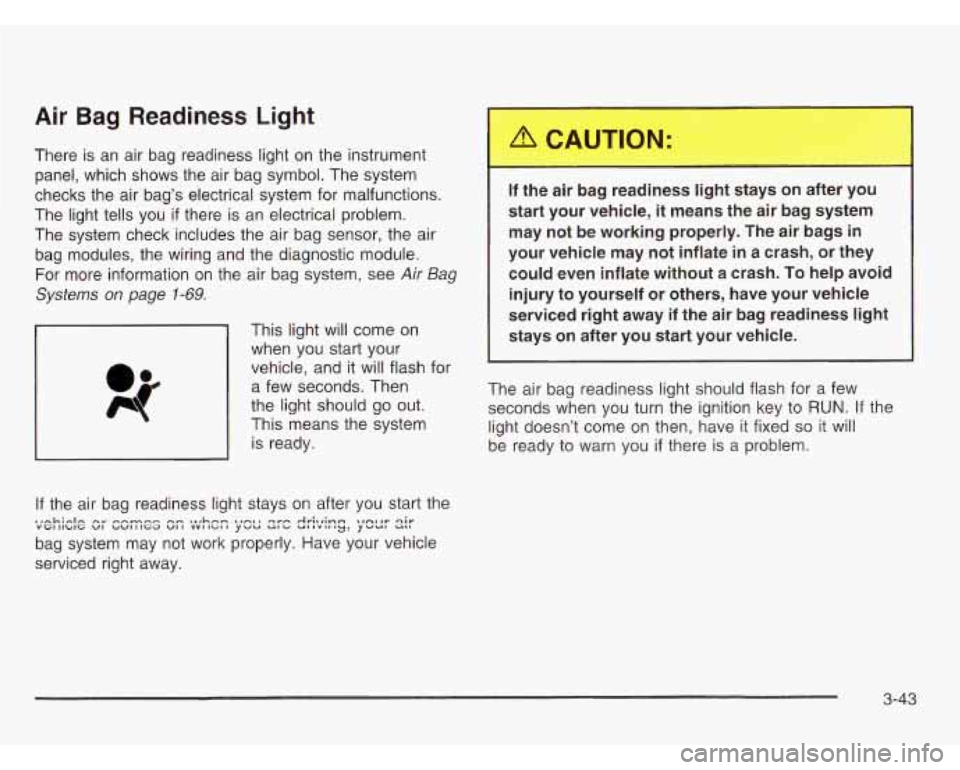
Air Bag Readiness Light
There is an air bag readiness light on the instrument
panel, which shows the air bag symbol. The system
checks the air bag’s electrical system for malfunctions.
The light tells you
if there is an electrical problem.
The system check includes the air bag sensor, the air
bag modules, the wiring and the diagnostic module.
For more information on the air bag system, see
Air Bag
Systems on page
1-69.
This light will come on
when you start your
vehicle, and it will flash for
a few seconds. Then
the light should go out.
This means the system
is ready.
If the air bag readiness light stays on after you start the
bag system may not work properly. Have your vehicle
serviced right away. .,nL;-lm nr n-mrrn nm ..rhn- ,,-ma qvn Av;~r;mrn \,A~*V qir VGIIIbIG VI bW111Ga VI1 YYIIGII YWU UI’V UiIViIIy’ YWUt UBI
If the air bag .eaG...ess light ,.ays on after y--
start your vehicle, it means the air bag system
may not be working properly. The air bags
in
your vehicle may not inflate in a crash, or they
could even inflate without a crash. To help avoid
injury to yourself or others, have your vehicle
serviced right away if the air bag readiness
light
stays on after you start your vehicle.
The air bag readiness light should flash for a few
seconds when you turn the ignition key to
RUN. If the
light doesn’t come on then, have it fixed
so it will
be ready to warn you
if there is a problem.
3-43
Page 201 of 466
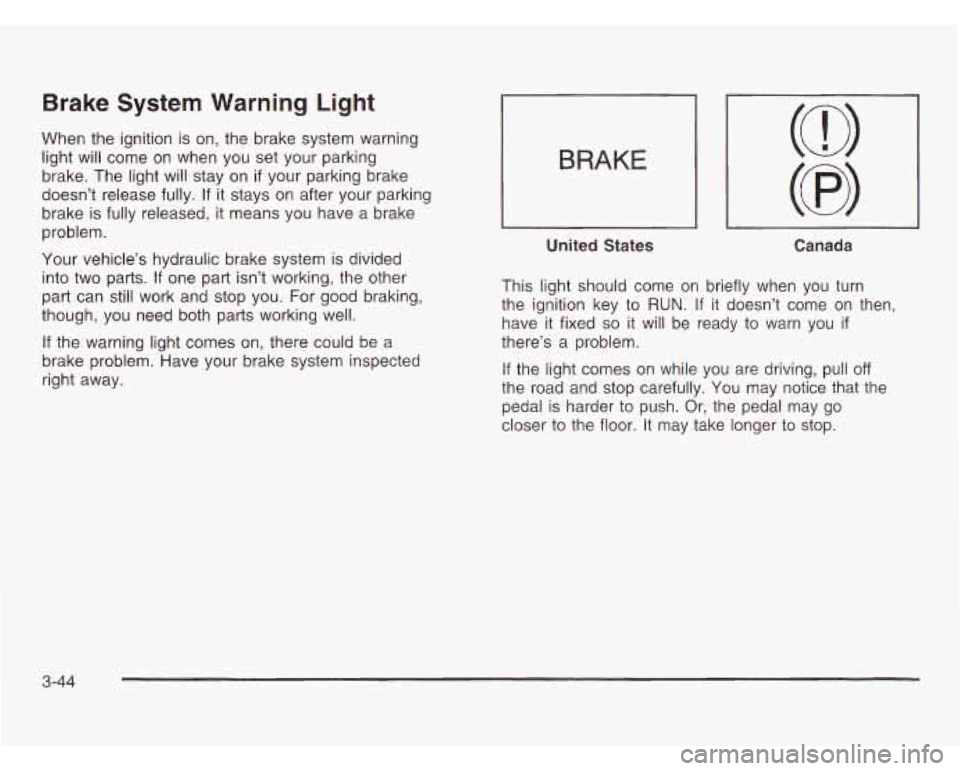
Brake System Warning Light
When the ignition is on, the brake system warning
light will come on when you set your parking
brake. The light will stay on
if your parking brake
doesn’t release fully.
If it stays on after your parking
brake is fully released, it means you have a brake
problem.
Your vehicle’s hydraulic brake system
is divided
into two parts. If one part isn’t working, the other
part can still work and stop you. For good braking,
though, you need both parts working well.
If the warning light comes on, there could be a
brake problem. Have your brake system inspected
right away.
BRAKE
United States Canada
This light should come on briefly when you turn
the ignition key to
RUN. If it doesn’t come on then,
have it fixed
so it will be ready to warn you if
there’s a problem.
If the light comes on while you are driving, pull
off
the road and stop carefully. You may notice that the
pedal is harder to push. Or, the pedal may go
closer
to the floor. It may take longer to stop.
3-44
Page 202 of 466

If the light is still on, have the vehicle towed for service.
See
Anti-Lock Brake System Warning Light on
F e 3-45 and Towing \’ rr Vehicle on page 4-32.
Your brake system may not be working
properly
if the brake system warning light is
on. Driving with the brake system warning light
on can lead to an accident.
If the light is still
on after you’ve pulled
off the road and stopped
carefully, have the vehicle towed for service.
r
Anti-Lock Brake System
Warning Light
Your vehicle may have
this light. If it does, the
anti-lock brake system
warning light should come
on for
a few seconds
when you turn the ignition
key to RUN.
If the anti-lock brake system warning light stays on
longer than normal after you’ve started your engine, turn
the ignition
off. Or, if the light comes on and stays on
when you’re driving, stop as soon as possible and turn
the ignition
off. Then start the engine again to reset
the system. If the light still stays on, or comes on again
while you’re driving, the anti-lock brake system needs
service and you don’t have anti-lock brakes.
-I -I. I- .I I^ .-,.- -..-I __.^___ :--. l:-.LL -L-..l-l -^-_ I I le dl Ill-IWGK UldKt: byblW i I vval I 111 ly llYl11 31 lwuiu bWl I IC
on briefly when you turn the ignition key to RUN.
If the light doesn’t come on then, have it fixed so it will
be ready to warn you if there
is a problem.
3-45
Page 206 of 466
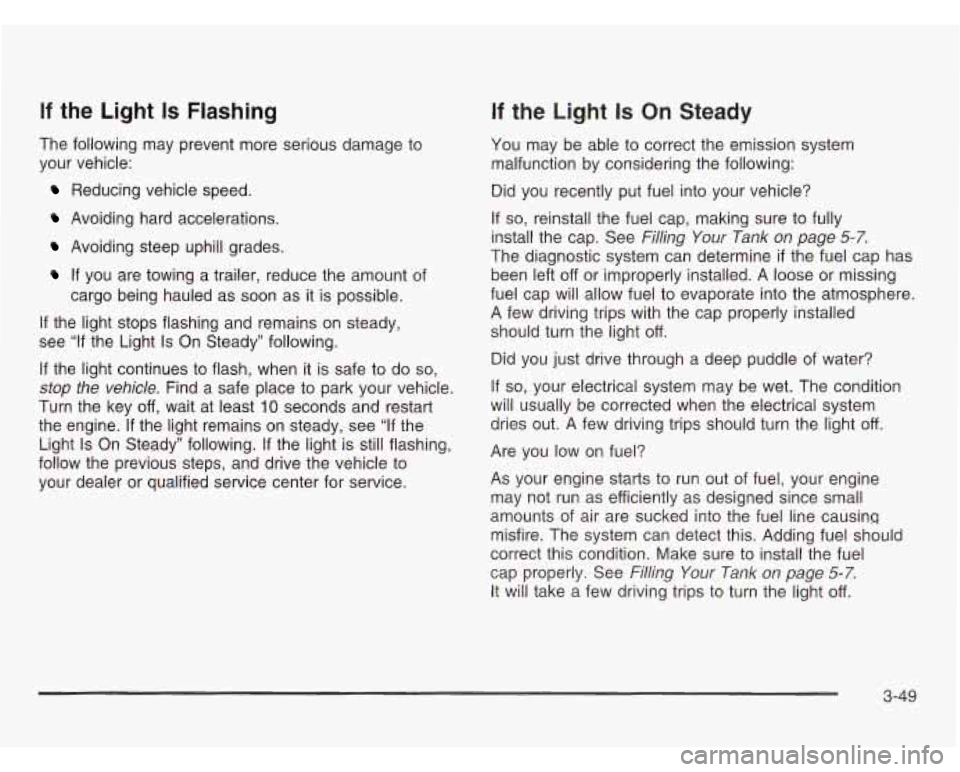
If the Light Is Flashing
The following may prevent more serious damage to
your vehicle:
Reducing vehicle speed.
Avoiding hard accelerations.
Avoiding steep uphill grades.
If you are towing a trailer, reduce the amount of
cargo being hauled as soon as
it is possible.
If the light stops flashing and remains on steady,
see
“If the Light Is On Steady” following.
If the light continues to flash, when it is safe to do so,
stop the vehicle. Find a safe place to park your vehicle.
Turn the key off, wait at least
10 seconds and restart
the engine. If the light remains on steady, see
“If the
Light
Is On Steady” following. If the light is still flashing,
follow the previous steps, and drive the vehicle to
your dealer or qualified service center for service.
If the Light Is On Steady
You may be able to correct the emission system
malfunction by considering the following:
Did you recently put fuel into your vehicle?
If
so, reinstall the fuel cap, making sure to fully
install the cap. See
Filling Your Tank on page 5-7.
The diagnostic system can determine if the fuel cap has
been left off or improperly installed.
A loose or missing
fuel cap will allow fuel to evaporate into the atmosphere.
A few driving trips with the cap properly installed
should turn the light
off.
Did you just drive through a deep puddle of water?
If so, your electrical system may be wet. The condition
will usually be corrected when the electrical system
dries out.
A few driving trips should turn the light off.
Are you low on fuel?
As your engine starts to run out of fuel, your engine
may not run as efficiently as designed since small
amounts of air are sucked into the fuel line causing
misfire. The system can detect this. Adding fuel should
correct this condition. Make sure to install the fuel
cap properly. See
Filling Your Tank on page 5-7.
It will take a few driving trips to turn the light off.
3-49
Page 215 of 466
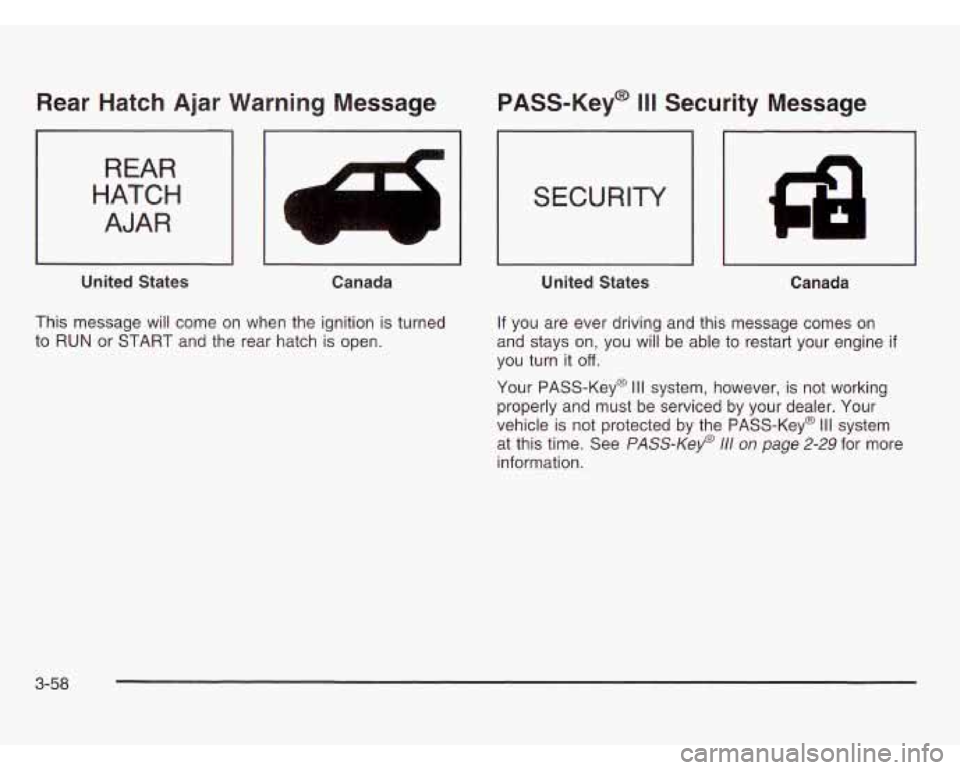
Rear Hatch Ajar Warning Message
77
REAR
HATCH
AJAR
I I
United States
I
Canada
This message will come on when the ignition is turned
to
RUN or START and the rear hatch is open.
PASS-Key@ 111 Security Message
SECURITY
Ga
I I I I
United States Canada
If you are ever driving and this message comes on
and stays on, you will be able to restart your engine
if
you turn it off.
Your PASS-Key@ Ill system, however, is not working
properly and must be serviced
by your dealer. Your
vehicle
is not protected by the PASS-Key@ Ill system
at this time. See
PASS-Key@ 111 on page 2-29 for more
information.
3-58
Page 267 of 466
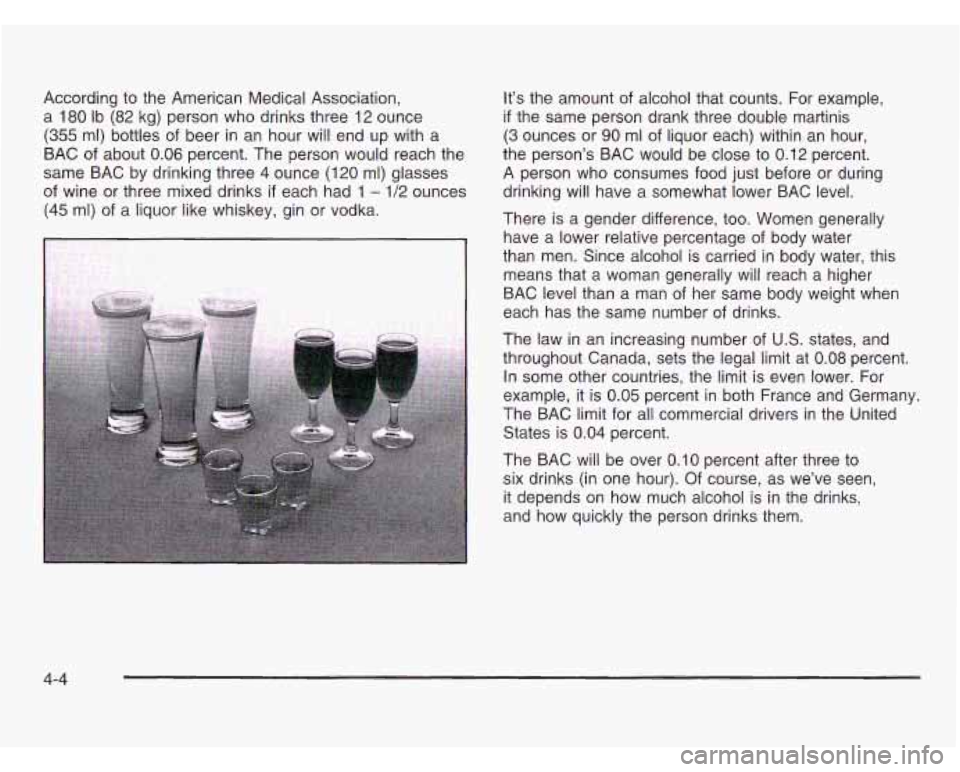
According to the American Medical Association,
a
180 Ib (82 kg) person who drinks three 12 ounce
(355 ml) bottles of beer in an hour will end up with a
BAC of about
0.06 percent. The person would reach the
same BAC by drinking three 4 ounce (120 ml) glasses
of wine
or three mixed drinks if each had 1 - 1/2 ounces
(45 ml) of a liquor like whiskey, gin or vodka. It’s
the amount
of alcohol that counts. For example,
if the same person drank three double martinis
(3 ounces or 90 ml of liquor each) within an hour,
the person’s BAC would be close to
0.12 percent.
A person who consumes food just before or during
drinking will have a somewhat lower BAC level.
There is a gender difference, too. Women generally
have a lower relative percentage of body water
than men. Since alcohol is carried in body water, this
means that a woman generally will reach a higher
BAC level than a man of her same body weight when
each has the same number of drinks.
The law in an increasing number of
U.S. states, and
throughout Canada, sets the legal limit at 0.08 percent.
In some other countries, the limit is even lower. For
example, it is 0.05 percent in both France and Germany.
The BAC limit for all commercial drivers in the United
States is 0.04 percent.
The BAC will be over
0.10 percent after three to
six drinks (in one hour). Of course, as we’ve seen,
it depends on how much alcohol is in the drinks,
and how quickly the person drinks them.
4-4
Page 296 of 466

Dinghy Towing Dolly Towing
Your vehicle was not designed to be towed with all of its
wheels on the ground.
If you have a two-wheel-drive
vehicle,
it can be towed with two of its wheels on
the ground. See “Dolly Towing” following.
If you have an
all-wheel-drive vehicle,
it cannot be towed with any of
its wheels on the ground. It can be towed with car carrier
equipment.
Notice: Towing an all-wheel-drive vehicle with all
four wheels on the ground, or even with only two of
its wheels on the ground, will damage drivetrain
components. Don’t tow an all-wheel-drive vehicle if
any
of its wheels will be on the ground. If
you have a two-wheel-drive vehicle, it can be towed
with two
of its wheels on the ground. To dolly tow
your vehicle, do the following:
1. Put the front wheels on a dolly.
2. Put the vehicle in PARK (P).
3. Set the parking brake and then remove the key.
4. Clamp the steering wheel in a straight-ahead
position with a clamping device designed for towing.
5. Release the parking brake.
If you have an all-wheel-drive vehicle, it cannot be
towed with any of its wheels on the ground. It can be
towed with car carrier equipment.
Notice: Towing an all-wheel-drive vehicle with all
four wheels on the ground,
or even with only two of
its wheels on the ground, will damage drivetrain
components. Don’t tow an all-wheel-drive vehicle if
any
of its wheels will be on the ground.
4-33
Page 298 of 466
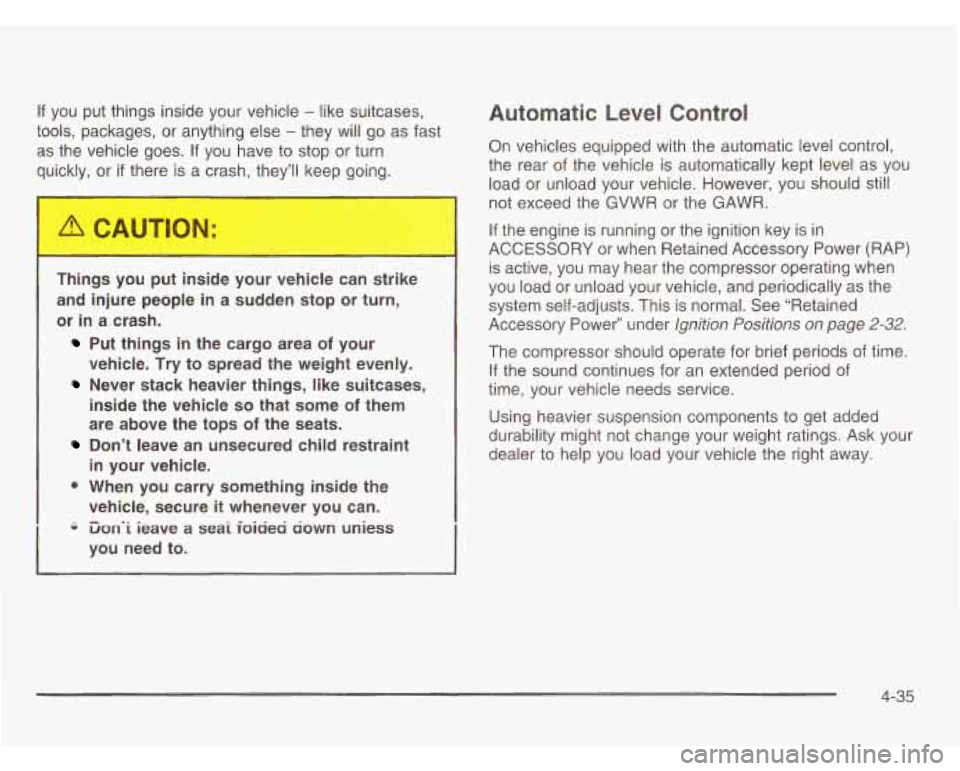
If you put things inside your vehicle - like suitcases,
tools, packages, or anything else
- they will go as fast
as the vehicle goes.
If you have to stop or turn
quickly, or
if there is a crash, they'll keep going.
Things you put inside your vehicle can strike
and injure people in a sudden stop or turn,
or
in a crash.
Put things in the cargo area of your
vehicle.
Try to spread the weight evenly.
Never stack heavier things, like suitcases,
inside the vehicle
so that some of them
are above the tops
of the seats.
Don't leave an unsecured child restraint
in your vehicle.
0 When you carry something inside the
vehicle, secure
it whenever you can.
i3on.i ieave a seai ioiciea ciown uniess
you need to.
Automatic Level Control
On vehicles equipped with the automatic level control,
the rear of the vehicle is automatically kept level as you
load or unload your vehicle. However, you should still
not exceed the GVWR or the GAWR.
If the engine is running or the ignition key is in
ACCESSORY or when Retained Accessory Power (RAP)
is active, you may hear the compressor operating when
you load or unload your vehicle, and periodically as the
system self-adjusts. This is normal. See "Retained
Accessory Power" under
Ignition Positions on page 2-32.
The compressor should operate for brief periods of time.
If the sound continues for an extended period of
time, your vehicle needs service.
Using heavier suspension components to get added
durability might not change your weight ratings. Ask your
dealer to help you load your vehicle the right away.
4-35
Page 325 of 466
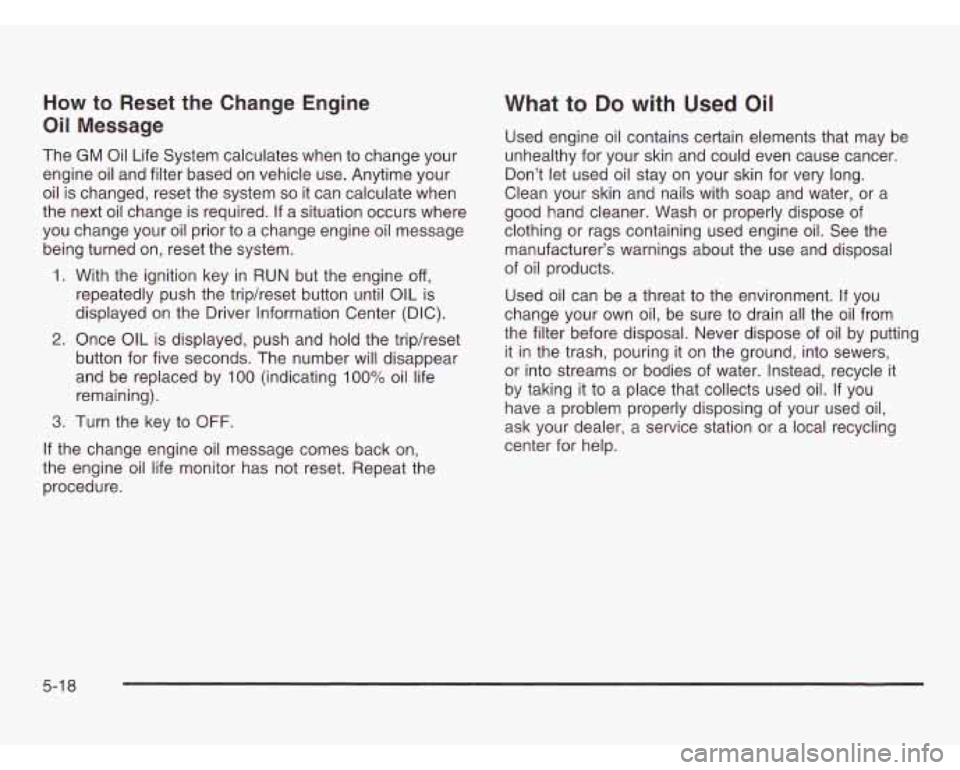
How to Reset the Change Engine
Oil Message
The GM Oil Life System calculates when to change your
engine oil and filter based on vehicle use. Anytime your
oil is changed, reset the system
so it can calculate when
the next oil change is required.
If a situation occurs where
you change your oil prior to a change engine oil message
being turned on, reset the system.
1. With the ignition key in RUN but the engine off,
repeatedly push the tripheset button until OIL is
displayed on the Driver Information Center (DIC).
2. Once OIL is displayed, push and hold the tripheset
button for five seconds. The number will disappear
and be replaced by
100 (indicating 100% oil life
remaining).
3. Turn the key to OFF.
If the change engine oil message comes back on,
the engine oil life monitor has not reset. Repeat the
procedure.
What to Do with Used Oil
Used engine oil contains certain elements that may be
unhealthy for your skin and could even cause cancer.
Don’t let used oil stay on your skin for very long.
Clean your skin and nails with soap and water, or a
good hand cleaner. Wash or properly dispose of
clothing or rags containing used engine oil. See the
manufacturer’s warnings about the use and disposal
of oil products.
Used oil can be a threat to the environment. If you
change your own oil, be sure to drain all the oil from
the filter before disposal. Never dispose of oil by putting
it in the trash, pouring it on the ground, into sewers,
or into streams or bodies of water. Instead, recycle it
by taking it to a place that collects used oil.
If you
have a problem properly disposing of your used oil,
ask your dealer, a service station or a local recycling
center for help.
5-1 8
Page 345 of 466
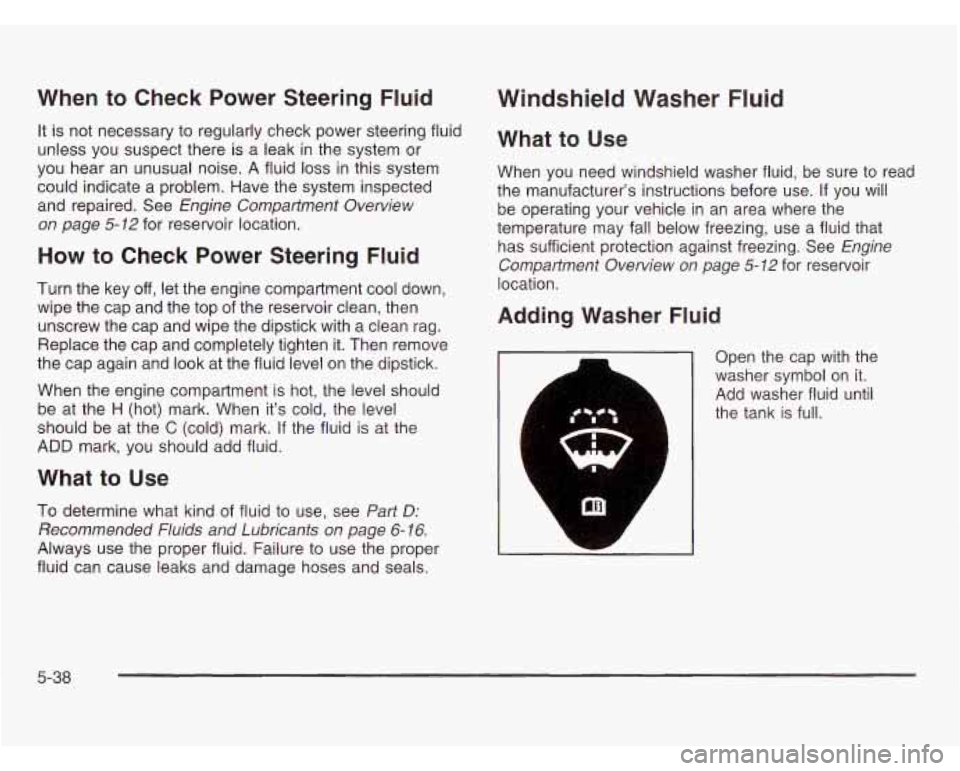
When to Check Power Steering Fluid
It is not necessary to regularly check power steering fluid
unless you suspect there is a leak in the system or
you hear an unusual noise.
A fluid loss in this system
could indicate a problem. Have the system inspected
and repaired. See
Engine Compartment Overview
on page
5- 72 for reservoir location.
How to Check Power Steering Fluid
Turn the key off , let the engine compartment cool down,
wipe the cap and the top
of the reservoir clean, then
unscrew the cap and wipe the dipstick with a clean rag.
Replace the cap and completely tighten
it. Then remove
the cap again and look at the fluid level on the dipstick.
When the engine compartment is hot, the level should
be at the H (hot) mark. When it’s cold, the level
should be at the
C (cold) mark. If the fluid is at the
ADD mark, you should add fluid.
What to Use
To determine what kind of fluid to use, see Part D:
Recommended Fluids and Lubricants on page 6-16.
Always use the proper fluid. Failure to use the proper
fluid can cause leaks and damage hoses and
seals.
Windshield Washer Fluid
What to Use
When you need windshield washer fluid, be sure to read
the manufacturer’s instructions before use.
If you will
be operating your vehicle in an area where the
temperature may fall below freezing, use a fluid that
has sufficient protection against freezing. See
Engine
Compartment Overview on page
5-12 for reservoir
location.
Adding Washer Fluid
. --
PA
Open the cap with the
washer symbol on it.
Add washer fluid until
the tank is full.
5-38